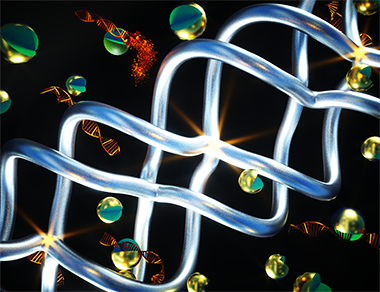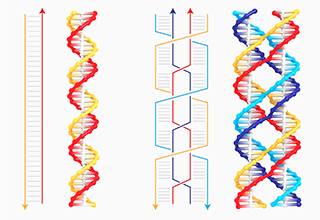Researchers' Newly Discovered Biostability in DNA Structures May Lead to Enhanced Therapeutics
 |
|
The RNA Institute team’s findings on new DNA biostability centers around the paranemic crossover (PX) DNA motif, depicted here. |
ALBANY, N.Y. (April 2, 2020) — A tremendous potential for biomedical applications, including targeted delivery of drugs, exists through DNA nanostructures, but one key challenge has been the limited stability of these structures in the body’s tissues and blood.
Now, a University team of researchers led by Arun Richard Chandrasekaran and Ken Halvorsen of the RNA Institute has circumvented that problem by discovering a potential direct route to biostability: an already existing biostable DNA motif capable of use in the design of new drug carriers and diagnostics.
Their study was released last week in an article in the Journal of American Chemical Society titled “Exceptional nuclease resistance of paranemic crossover (PX) DNA and crossover-dependent biostability of DNA motifs.”
DNA can be used as a building material to assemble nanostructures, and the starting units of these are usually DNA "motifs" made up of multiple DNA strands. A prominent application of DNA nanotechnology is in drug delivery, where these nanostructures could carry drugs to desired target sites.
The RNA Institute team’s work centers around the paranemic crossover (PX) DNA motif: a four-stranded structure in which two parallel juxtaposed double-helical domains are fused by crossovers at every point, and whose twists are approximately half of those of conventional DNA.
 |
|
Left to right, a DNA double helix and a pananemic crossover (PX) DNA. Researchers theorize the multiple crossovers of the PX DNA make the structure tightly wound and prevent the frequent bio-instability of the duplex DNA. |
“In our study, we discovered that the PX motif has exceptional biostability, which we found was related to the number of times the strands in the motif switch between different duplex regions — called "crossovers,"” said Chandrasekaran. “In essence, our study discusses the potential of enhancing inherent biostability of DNA nanostructures by bottom-up design.”
The team, also consisting of Biological Sciences faculty Bijan Dey, Siu Wah Wong-Deyrup and Paromita Dey, and undergraduate researcher Javier Vilcapoma, made two breakthroughs, the first being that the PX DNA has remarkable nuclease resistance and biostability and the second being that the biostability is correlated to the number of crossover points.
Other research into stabilizing DNA nanostructureshas centered upon chemically modifying DNA nanostructures to extend their survival long enough for therapeutic applications. This approach, however, could have some adverse effects for in vivo applications that an all-natural DNA nanostructure might not.
Even so, Chandrasekaran said there could be compatibility and even synergy between the two approaches. “Our study shows how some DNA nanostructures can be inherently more biostable. If the need arises for even more stability, chemical modifications can also be added to our DNA nanostructure design and increase the biostability even further.”
Halvorsen says that the study provides a new tool for DNA based design. “Our work suggests that biostability can be engineered into DNA structures, potentially enabling a new level of control over the timing of structural degradation. Ultimately, such control will bring DNA nanostructures closer to biomedical applications, such as drug delivery.”
![]() For more news, subscribe to UAlbany's RSS headline feeds
For more news, subscribe to UAlbany's RSS headline feeds
A comprehensive public research university, the University at Albany-SUNY offers more than 120 undergraduate majors and minors and 125 master's, doctoral and graduate certificate programs. UAlbany is a leader among all New York State colleges and universities in such diverse fields as atmospheric and environmental sciences, business, education, public health,health sciences, criminal justice, emergency preparedness, engineering and applied sciences, informatics, public administration, social welfare and sociology, taught by an extensive roster of faculty experts. It also offers expanded academic and research opportunities for students through an affiliation with Albany Law School. With a curriculum enhanced by 600 study-abroad opportunities, UAlbany launches great careers.


